The title of Club Transmediale‘s exhibition, Alles, was Sie über Chemie wissen müssen (Everything You Need to Know about Chemistry), is based on a notebook with blank pages, published by an international science publisher.
An intriguing and cheeky enough opening for me.
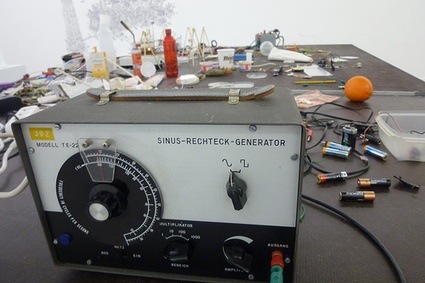 Martin Howse and Martin Kuentz, remains of the Substrate performance
Martin Howse and Martin Kuentz, remains of the Substrate performance
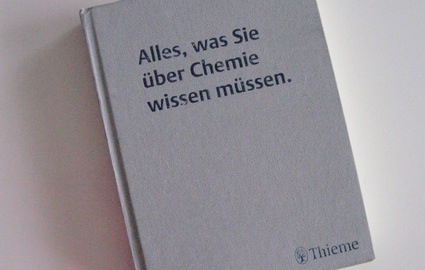
No matter how much I love exhibitions at new media art festivals, i often find myself suspecting that the curatorial vision behind many of them is little more than an after-thought. This was certainly not the case with Alles, was Sie über Chemie wissen müssen and i can’t praise curators Hicham Khalidi and Suzanne Wallinga enough for their exquisite, intelligent contribution to Club Transmediale.
The show wasn’t afraid to call upon works from the early ’70s to dialogue with new pieces on a theme that others than Khalidi and Wallinga might have been explored in a fairly lazy way: the physical interaction between people and things. To be honest, the description of the exhibition theme was a bit intimidating, the show attempts to convey an experience of Befindlichkeit (existential orientation), of the physical interaction between people and things, as described, for example, by Gernot Böhme: a primary experience of atmosphere, of “moods” that can be encountered in human and natural surroundings, in which there is no sharp distinction between person and thing. In Alles, was Sie über Chemie wissen müssen, the experience of winds, of feeling, of substance occurs through different manners of physical presence. The relationship between body and medium leads, either through the creation or perception of work, to the experience of a mental space where alternative ways of understanding the body may arise.
You didn’t have to read Heidegger to find the show entirely enjoyable though.
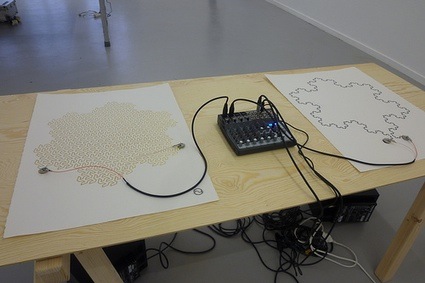
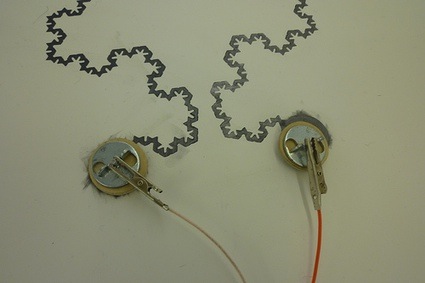
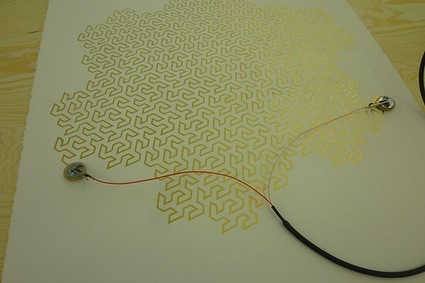
One of the works that best concretized the theme of the exhibition is Aura by Joyce Hinterding, an artist whose practice investigates energetic forces, in particular acoustic and electromagnetic phenomena. Aura is made of graphite and gold drawings which, when connected to a sound system, become fractal antennas. As soon as i took off my camera to take a picture, i realized that the drawings made audible the presence of electromagnetic fields within the gallery. A text about the work explains that tracing one’s finger over Hinterding’s lines produces electrical sounds akin to those emitted by a theremin” but since i’m still not used to manipulating artworks, unless specifically invited to do so, i didn’t dare touch the drawings. Besides, there was a guard in the room.
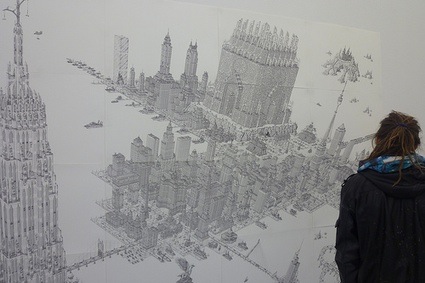 Rik Smits, Scorpoda Capita
Rik Smits, Scorpoda Capita
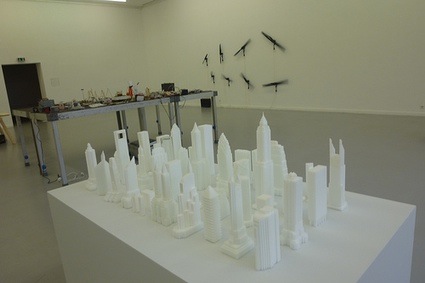 Rik Smits, Scorpoda Capital, model, 2011
Rik Smits, Scorpoda Capital, model, 2011
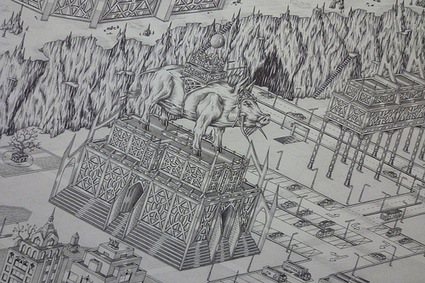 Rik Smits, Scorpoda Capital, 2009-2010
Rik Smits, Scorpoda Capital, 2009-2010
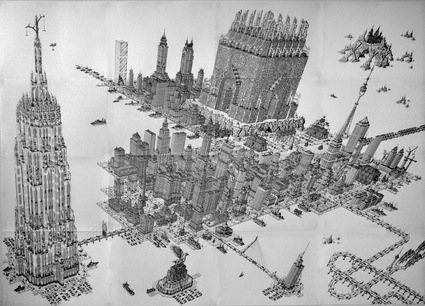 Rik Smits, Scorpoda Capital, 2009-2010(image)
Rik Smits, Scorpoda Capital, 2009-2010(image)
Rik Smits‘s ballpoint drawing Scorpoda Capital is a fascinating, slightly fearsome city driven by a taste for Dubai-worthy architecture, self-importance and luxury. Add to those, hints to the darkest chapters from the Old Testament (but that might just be my imagination) and an eerie absence of visible human beings.
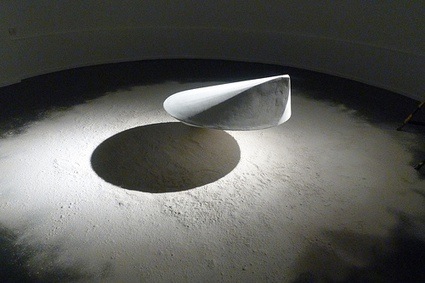 Jelle Feringa, Analemma
Jelle Feringa, Analemma
Jelle Feringa‘s Analemma was probably the most insidiously fascinating piece in the show. In astronomy, an analemma (from a Greek word that meant “pedestal of a sundial”) is a figure of eight-like curved traced in the sky when the position of the Sun is plotted at the same time each day over a calendar year from a particular location on Earth.
Feringa’s Analemma defies the earth’s 29.783 km/sec velocity by casting a perfectly circular shadow on the ground. No matter the time of the day, the day in the year, the latitude.
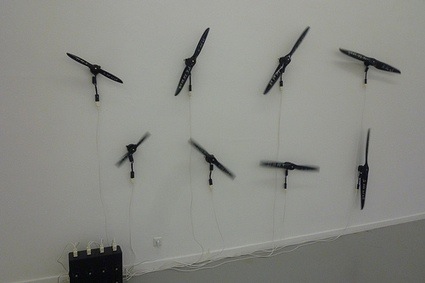
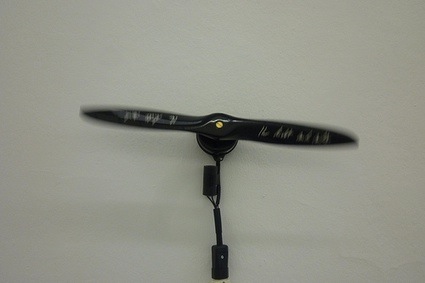 Jorinde Voigt, Grammatik, 2010
Jorinde Voigt, Grammatik, 2010
Jorinde Voigt‘s Grammatik combines several parameters, such as spinning aeroplane propellers, writing on the propellers (64 grammatical possibilities, declination of the personal pronouns, who loves who, who doesn’t love who) and the size of the blades (the first person singular corresponds to the biggest blade. The third person plural corresponds to the smallest blade). Next to that, the installation defines the grammatical system even more precise by the declination of the rotation speed, 0 to maximum, individually controllable speed (the artist does not specify how fast each blade has to turn; every speed within the possible range is correct) and the declination of the direction of rotation: turning to the left or to the right. Technically, this corresponds to whether the blade turns away from or towards the observer.
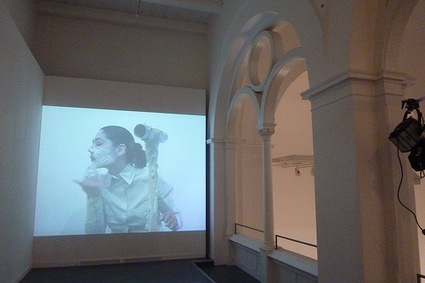
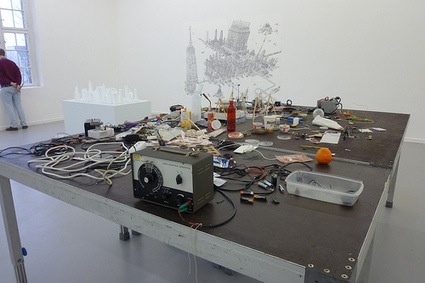
Loved the show, took tons of pictures.
